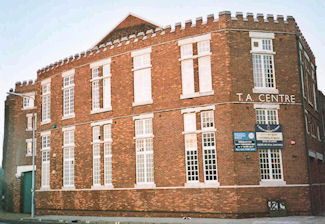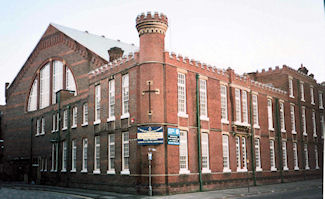Portsmouth
Connaught Halls
The Connaught drill hall, Alfred road, is recorded in Kelly, 1899. ‘The Drill Hall, Alfred road, is a fine structure of red brick with stone dressings, from designs by Mr. A. H. Bone, architect, and is estimated to hold 11,000 people; the hall is primarily intended for the use of the 3rd Volunteer Battalion (Duke of Connaught’s Own), Hampshire Regiment, but is also let for meetings and entertainments.’
The Drill Hall was acquired by the Admiralty to allow for the construction of barracks and a new site was offered to the Volunteers. See Connaught Hall, Stanhope street, below.
We believe that this report from The Times, Tuesday, January 19th, 1886, probably refers to the Alfred road Drill Hall: ‘General Sir George Willis, commanding the Southern Military District, opened a new Volunteer drill-hall at Portsmouth last evening. It is the largest building of the kind in the south of England, measuring 147ft. by 143ft., and is estimated to contain standing accommodation for 10,520 persons.’ (Corroboration of the reference would be welcomed.)
This building is now part of the Naval Base within the Naval Barracks.
On Monday, June 5th, 1899, The Times reported: ‘The Admiralty, having acquired the drill-hall of the 3rd Vol. Batt. Hampshire regt., Portsmouth, in connexion with the new naval barracks, have granted a new site. The foundation-stone of the new Volunteer drill-hall was laid on Saturday afternoon by Col. A. F. Perkins, a former commanding officer of the battalion.’
The Times, Monday, Mar 11, 1901: ‘In the absence of the Duke of Connaught, who is hon. Colonel of the battalion, Lord Northbrook, lord lieutenant of Hampshire, on Saturday opened a large and handsome drill-hall at Portsmouth which has been erected for the 3rd V.B. (Duke of Connaught’s Own) Hampshire Regt. by the Admiralty, who have included the original drill-hall of the battalion in the area enclosed for the new naval barracks. There was a large attendance of officers of the Regular and Auxiliary forces, and the battalion mustered about 600 strong, in addition to the guard of honour which received the lord lieutenant. They had a completely organised transport corps, fully trained bearers and signallers, and a machine gun detachment, but the gun had been sent to South Africa. They entered their new home without any cost to the battalion funds. Lord Northbrook, before declaring the hall open, paid a warm tribute to the patriotism of the Hampshire Volunteers in sending contingents to South Africa.’
In 1911, Kelly records: ‘6th Battalion Hampshire Regiment; head quarters, A, B, C & D Companies, Connaught hall, Stanhope road, Landport.’ He also notes: ‘3rd Wessex Field Ambulance, Royal Army Medical Corps; [temporary] head quarters and A Section, Drill hall, Stanhope road’ and ‘A Squadron Hampshire (Carabiniers) Yeomanry, 3rd Hants Drill hall, Stanhope road, Landport.’
The Drill Hall is described in ‘Hampshire Treasures, Volume 11, ( Portsmouth) - Man-made Features (Stanhope Road)’: ‘Connaught Drill Hall. Very wide gabled roof. Brick battlemented facade with two rows of windows with glazing bars. Wide doorway with imitation stone lintel. To the south two battlemented chimneys. To the south-west corner, a battlemented round turret with imitation arrow slit. Attributed to A. Bone. Partially damaged during the war, reconstructed after.’
The Drill Hall is owned by the Connaught Drill Hall Trust. The Army ceased using the building in about 1997 and it was used as a temporary mail sorting office. In 2001, the Drill Hall was threatened by demolition and replacement by student accommodation.
Arguing for the retention and re-use of the Drill Hall, The Portsmouth Society News, 2001, describes the building. The author says, ‘It forms a kind of facade for the commercial part of the city centre which is divided from the civic centre by the railway and station. It is mainly one single uninterrupted space with the roof supported by steel trusses. Particularly noticeable is the way in which the architect has turned the bend of the road by a series of stepped frontages.’
Following uncertainly about its future, this drill hall was Grade II listed in 2001. It is now a night club.
Thank you to Keith Roberts for his photographs. Unattributed photographs are by Graeme Fisher.
The Drill Hall was acquired by the Admiralty to allow for the construction of barracks and a new site was offered to the Volunteers. See Connaught Hall, Stanhope street, below.
We believe that this report from The Times, Tuesday, January 19th, 1886, probably refers to the Alfred road Drill Hall: ‘General Sir George Willis, commanding the Southern Military District, opened a new Volunteer drill-hall at Portsmouth last evening. It is the largest building of the kind in the south of England, measuring 147ft. by 143ft., and is estimated to contain standing accommodation for 10,520 persons.’ (Corroboration of the reference would be welcomed.)
This building is now part of the Naval Base within the Naval Barracks.
On Monday, June 5th, 1899, The Times reported: ‘The Admiralty, having acquired the drill-hall of the 3rd Vol. Batt. Hampshire regt., Portsmouth, in connexion with the new naval barracks, have granted a new site. The foundation-stone of the new Volunteer drill-hall was laid on Saturday afternoon by Col. A. F. Perkins, a former commanding officer of the battalion.’
The Times, Monday, Mar 11, 1901: ‘In the absence of the Duke of Connaught, who is hon. Colonel of the battalion, Lord Northbrook, lord lieutenant of Hampshire, on Saturday opened a large and handsome drill-hall at Portsmouth which has been erected for the 3rd V.B. (Duke of Connaught’s Own) Hampshire Regt. by the Admiralty, who have included the original drill-hall of the battalion in the area enclosed for the new naval barracks. There was a large attendance of officers of the Regular and Auxiliary forces, and the battalion mustered about 600 strong, in addition to the guard of honour which received the lord lieutenant. They had a completely organised transport corps, fully trained bearers and signallers, and a machine gun detachment, but the gun had been sent to South Africa. They entered their new home without any cost to the battalion funds. Lord Northbrook, before declaring the hall open, paid a warm tribute to the patriotism of the Hampshire Volunteers in sending contingents to South Africa.’
In 1911, Kelly records: ‘6th Battalion Hampshire Regiment; head quarters, A, B, C & D Companies, Connaught hall, Stanhope road, Landport.’ He also notes: ‘3rd Wessex Field Ambulance, Royal Army Medical Corps; [temporary] head quarters and A Section, Drill hall, Stanhope road’ and ‘A Squadron Hampshire (Carabiniers) Yeomanry, 3rd Hants Drill hall, Stanhope road, Landport.’
The Drill Hall is described in ‘Hampshire Treasures, Volume 11, ( Portsmouth) - Man-made Features (Stanhope Road)’: ‘Connaught Drill Hall. Very wide gabled roof. Brick battlemented facade with two rows of windows with glazing bars. Wide doorway with imitation stone lintel. To the south two battlemented chimneys. To the south-west corner, a battlemented round turret with imitation arrow slit. Attributed to A. Bone. Partially damaged during the war, reconstructed after.’
The Drill Hall is owned by the Connaught Drill Hall Trust. The Army ceased using the building in about 1997 and it was used as a temporary mail sorting office. In 2001, the Drill Hall was threatened by demolition and replacement by student accommodation.
Arguing for the retention and re-use of the Drill Hall, The Portsmouth Society News, 2001, describes the building. The author says, ‘It forms a kind of facade for the commercial part of the city centre which is divided from the civic centre by the railway and station. It is mainly one single uninterrupted space with the roof supported by steel trusses. Particularly noticeable is the way in which the architect has turned the bend of the road by a series of stepped frontages.’
Following uncertainly about its future, this drill hall was Grade II listed in 2001. It is now a night club.
Thank you to Keith Roberts for his photographs. Unattributed photographs are by Graeme Fisher.
Stanhope Street - View from Edinburgh Road
Photograph: Keith Roberts
Photograph: Keith Roberts

Stanhope Street

Stanhope Street - View from Edinburgh Road
Stanhope Street - View from Edinburgh Road
Photograph: Keith Roberts
Photograph: Keith Roberts
Stanhope Street - View from Willis Road
Photograph: Keith Roberts
Photograph: Keith Roberts
© All material is copyright - refer to the
Terms of Use
the first attempt at content
Introduction
About
Anatomy
Drill
 Database
Database
 Memorabilia
Memorabilia
Resources Glossary
Saving Halls Participate Contact What's New? Terms of Use
Drill
 Database
Database Memorabilia
MemorabiliaResources Glossary
Saving Halls Participate Contact What's New? Terms of Use
The Drill Hall Project - Charting a neglected legacy